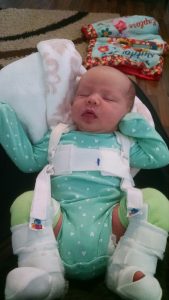Hip dysplasia: have you ever heard of it? Don’t feel bad if you haven’t because up until about two years ago, I had never heard of it either. Little did I know, I would soon become very familiar with the term. Soon I was accustomed to looking at hip x-rays and quickly on my way to becoming an expert at putting on hip braces.
The Diagnosis
While still in the hospital after having our third child, the pediatrician came in to give the “once over” as they do each day after baby is born. I didn’t think anything of it. This was my third baby and my other babies were always given a clean bill of health. However, this time I watched the doctor put my baby girl’s legs in the frog position and hesitate. I quickly went over and watched intently as she did it again. And I could tell something wasn’t right.
“I think she might have hip dysplasia. I will have the radiologist come up and do an ultrasound to confirm.”
As soon as she left, I cried. Between postpartum hormones and having no idea what hip dysplasia was, I was scared. Was she going to need surgery? Physical therapy? Was she going to walk with a limp?
The radiologist came up and wheeled in his ultrasound machine. It didn’t take very long to confirm what the pediatrician had suspected. And my daughter was diagnosed with developmental hip dysplasia.
What exactly is hip dysplasia you may ask? The Mayo Clinic defines hip dysplasia as the medical term for when a hip socket doesn’t fully cover the ball portion of the upper thighbone. This allows the hip joint to become partially or completely dislocated. Most people with hip dysplasia are born with the condition.
Braces, X-Rays, and Appointments
The next week we went in for our first orthopedic clinic appointment and got fitted for a soft brace called a Pavlik harness. This brace keeps the baby’s legs in the frog position. When I found out we had to keep the brace on her 23 hours a day for 12 weeks, it was overwhelming.
My daughter couldn’t wear sleepers due to how it would restrict her hips/legs in the brace, or even be in a baby-wearing carrier because of how her hips would sit. I will say the most difficult part for me was the middle of the night diaper changes with the brace. But honestly, she didn’t seem to be bothered too much by the constant brace wearing. Once those 12 weeks were up, she then wore a hard brace every night until she was six months old.

We were in the orthopedic clinic every two weeks and then every month up until that half-year mark. At that point, we graduated from braces, but that wasn’t the end. The doctors still monitor her hip at every orthopedic appointment and at every pediatrician well-check.
Now, finally at her two-year orthopedic appointment we were told that she had been taken out of the probability of needing to have hip surgery in childhood. I would’ve hugged her ortho doctor if it wasn’t for COVID restrictions!
Is All This Necessary?
You maybe reading this thinking, is this really necessary? Braces for 23 hours a day for months on end?! Her orthopedic doctor was so kind to explain to us that if we choose to do nothing (meaning no braces, no intervention of any sort), children with the degree of hip dysplasia she has, probably wouldn’t notice anything until about age five. He said usually kids with hip dysplasia that are left untreated may not be able to run as fast as the other kids in school. Then as they get to about their teenage years they will start to to get more hip pain and may end up needing surgery at this time.
My husband and I realized that we needed to do everything we could to make sure our daughter is able to do everything she wants to do. And will not be held back by her hip issues.
What the Future Holds
As thankful as I am that she shouldn’t need hip surgery in childhood, that doesn’t mean everything will be “perfect.” There will still be lots of orthopedic appointments and x-rays to make sure that her hips are staying where they should be. She will be best buds with her orthopedic doctor for years to come. But my husband and I can be confident that we did the most we could through early intervention to help our daughter.
To learn more about hip dysplasia please visit the International Hip Dysplasia Institute.
















